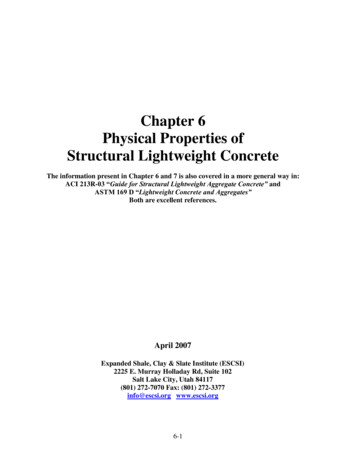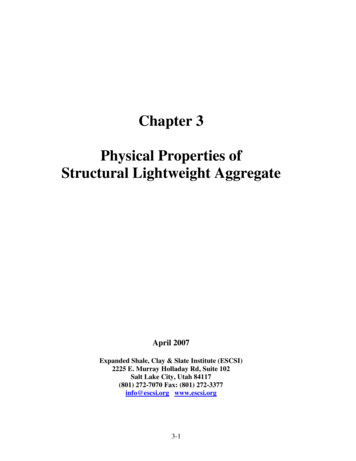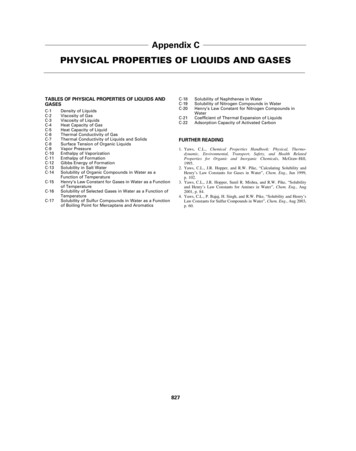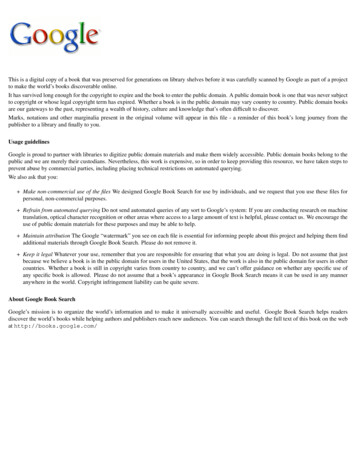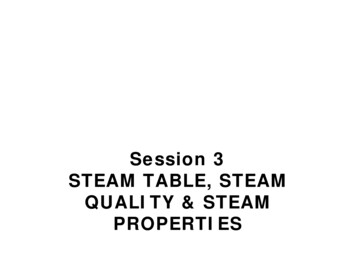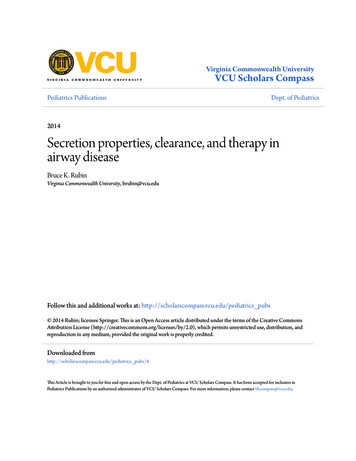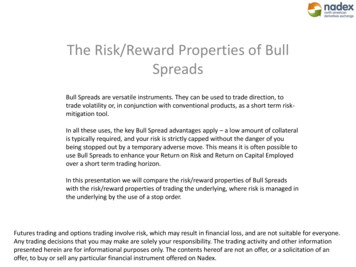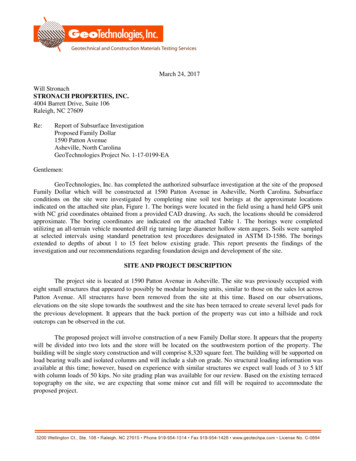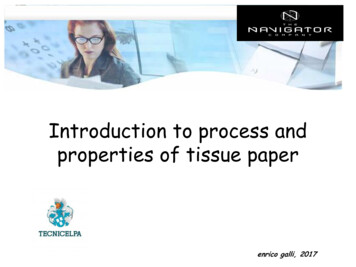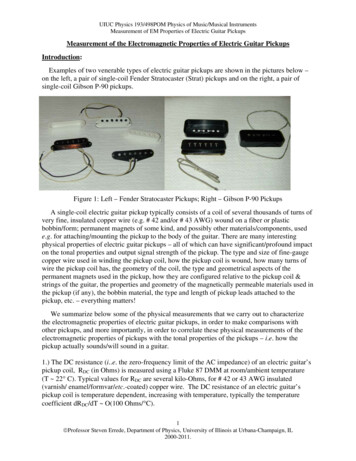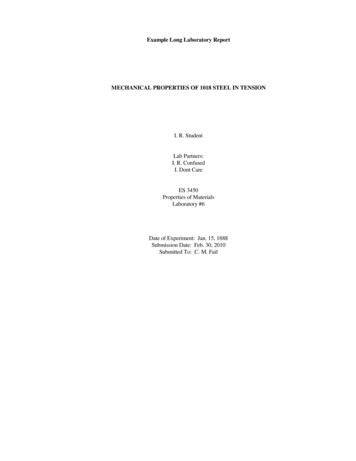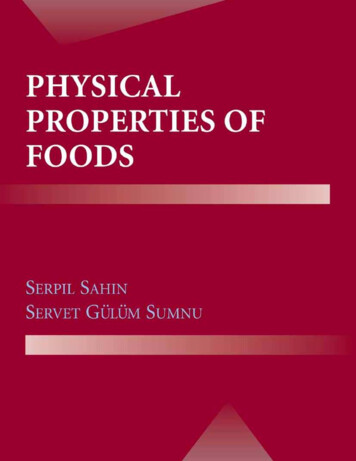
Transcription
Physical Propertiesof Foods
FOOD SCIENCE TEXT SERIESThe Food Science Text Series provides faculty with the leading teaching tools. The Editorial Boardhas outlined the most appropriate and complete content for each food science course in a typical foodscience program and has identified textbooks of the highest quality, written by the leading food scienceeducators.Series EditorDennis R. Heldman, Heldman Associates, San Marcos, CaliforniaEditorial BoardDavid A. Golden, Professor of Food Microbiology, Department of Food Science and Technology,University of TennesseeRichard W. Hartel, Professor of Food Engineering, Department of Food Science, University of WisconsinHildegarde Heymann, Professor of Food Sensory Science, Department of Food Science and Technology,University of California—DavisJoseph H. Hotchkiss, Professor, Institute of Food Science and Institute for Comparative and EnvironmentalToxicology, and Chair, Food Science Department, Cornell UniversityMichael G. Johnson, Professor of Food Safety and Microbiology, Department of Food Science,University of ArkansasJoseph Montecalvo, Jr., Professor, Department of Food Science and Nutrition, California Polytechnic andState University—San Luis ObispoS. Suzanne Nielsen, Professor and Chair, Department of Food Science, Purdue UniversityJuan L. Silva, Professor, Department of Food Science, Nutrition and Health Promotion, Mississippi StateUniversityTitlesElementary Food Science, Fourth Edition, Ernest R. Vieira (1996)Essentials of Food Sanitation, Norman G. Marriott (1997)Essentials of Food Science, Second Edition, Vickie A. Vaclavik and Elizabeth W. Christian (2003)Food Analysis, Third Edition, S. Suzanne Nielsen (2003)Food Analysis Laboratory Manual, S. Suzanne Nielsen (2003)Food Science, Fifth Edition, Norman N. Potter and Joseph H. Hotchkiss (1995)Fundamentals of Food Processing, Third Edition, Romeo T. Toledo (2006)Introduction to Food Processing, P. G. Smith (2003)Modern Food Microbiology, Seventh Edition, James M. Jay, Martin J. Loessner,and David A. Golden (2005)Physical Properties of Foods, Serpil Sahin and Servet Gülüm Sumnu (2006)Principles of Food Chemistry, Third Edition, John M. de Man (1999)Principles of Food Processing, Dennis R. Heldman and Richard W. Hartel (1997)Principles of Food Sanitation, Fifth Edition, Norman G. Marriott and Robert B. Gravani (2006)Sensory Evaluation of Food: Principles and Practices, Harry T. Lawless and Hildegarde Heymann (1998)
Physical Propertiesof FoodsSerpil Sahin and Servet Gülüm SumnuMiddle East Technical UniversityAnkara, Turkey
Servet Gülüm SumnuDepartment of Food EngineeringMiddle East Technical UniversityAnkara, 06531Turkeygulum@metu.edu.trSerpil SahinDepartment of Food EngineeringMiddle East Technical UniversityAnkara, 06531Turkeyserp@metu.edu.trLibrary of Congress Control Number: 2005937128ISBN-10: 0-387-30780-XISBN-13: 978-0387-30780-0e-ISBN 0-387-30808-3Printed on acid-free paper. C 2006 Springer Science Business Media, LLC.All rights reserved. This work may not be translated or copied in whole or in part without the written permission of thepublisher (Springer Science Business Media, LLC., 233 Spring Street, New York, NY 10013, USA), except for brief excerptsin connection with reviews or scholarly analysis. Use in connection with any form of information storage and retrieval, electronicadaptation, computer software, or by similar or dissimilar methodology now known or hereafter developed is forbidden.The use in this publication of trade names, trademarks, service marks, and similar terms, even if they are not identified as such,is not to be taken as an expression of opinion as to whether or not they are subject to proprietary rights.Printed in the United States of America.9 8 7 6 5 4 3 2 1springer.com(TB/MVY)
TO OUR PARENTSSEMİHA-ŞEVKET SAHIN&EMİNE-ERDOǦAN SUMNUWho have given us our roots
PrefaceWe have been teaching an undergraduate course of Physical Properties of Foods in Department ofFood Engineering in Middle East Technical University for four years. We have had difficulty in findinga suitable textbook for undergraduate students since standard physical properties of foods books do notcover all the physical properties such as size, shape, volume and related physical attributes, rheologicalproperties, thermal properties, electromagnetic properties, water activity and sorption properties, andsurface properties together. In addition, engineering concepts and physical chemistry knowledge arenot combined in these books.We tried to write a book to provide a fundamental understanding of physical properties of foods.In this book, the knowledge of physical properties is combined with food science, physical chemistry,physics and engineering knowledge. Physical properties data are required during harvesting, processing, storage and even shipping to the consumer. The material in the book will be helpful for the studentsto understand the relationship between physical and functional properties of raw, semi-finished andprocessed food to obtain products with desired shelf-life and quality.This book discusses basic definitions and principles of physical properties, the importance of physical properties in food industry and measurement methods. Moreover, recent studies in the area ofphysical properties are summarized. In addition, each chapter is provided with examples and problems.These problems will be helpful for students for their self-study and to gain information how to analyzeexperimental data to generate practical information.This book is written to be a textbook for undergraduate students which will fill the gap in physicalproperties area. In addition, the material in the book may be of interest to people who are working in thefield of Food Science, Food Technology, Biological Systems Engineering, Food Process Engineeringand Agricultural Engineering. It will also be helpful for graduate students who deal with physicalproperties in their research.The physical properties of food materials are discussed in 6 main categories such as size, shape,volume and related physical attributes, rheological properties, thermal properties, electromagneticproperties, water activity and sorption properties and surface properties in this book. In the first chapter physical attributes of foods which are size, shape, volume, density and porosity are discussed.Methods to measure these properties are explained in details. In Chapter 2, after making an introduction on Newtonian and non-Newtonian fluid flow, viscosity measurement methods are discussed.Then, principle of viscoelastic fluids, methods to determine the viscoelastic behavior and modelsused in viscoelastic fluids are mentioned. Chapter 3 explains definition and measurement methods ofthermal properties such as thermal conductivity, specific heat, thermal diffusivity and enthalpy. In thevii
viiiPrefacefourth chapter color and dielectric properties of foods are covered. In Chapter 5, equilibrium criteriaand colligative properties are discussed. Then, information is given on measurement of water activity.Finally preparation of sorption isotherms and models are discussed. The last chapter is about surfaceproperties and their measurement methods. Where appropriate, we have cited throughout the text thearticles that are available for more information.We are deeply grateful to Prof. Dr. Haluk Hamamci for encouraging us during writing this bookand his belief in us. We would also like to thank our colleagues Prof. Dr. Ali Esin, Prof. Dr. HalukHamamci, Assoc. Prof. Dr. Nihal Aydogan, Assoc. Prof. Dr. Pinar Calik, Assoc. Prof. Dr. NaimeAsli Sezgi, Assoc. Prof. Dr. Esra Yener, Assist. Prof. Dr. Yusuf Uludag, who read the chapters andgave useful suggestions. We would also like to thank our Ph.D student Halil Mecit Oztop and hisbrother Muin S. Oztop for drawing some of the figures. We would like to extend our thanks to ourPh.D students, Isil Barutcu, Suzan Tireki, Semin Ozge Keskin, Elif Turabi and Nadide Seyhun forreviewing our book. We are happy to acknowledge the teaching assistants Aysem Batur and IncinurHasbay for their great effort in drawing some of the figures, finding the examples and problems givenin each chapter.Last but not the least; we would like to thank our families for their continuous support throughoutour academic career. With love, this work is dedicated to our parents who have patience and belief inus. Thank you for teaching us how to struggle the difficulties in life.Ankara-TURKEYOctober 29, 2005Serpil SahinServet Gülüm Sumnu
Contents1—Size, Shape, Volume, and Related Physical Attributes . . . . . . . . . . . . . . . . . . . . . . . . . . . . .Summary . . . . . . . . . . . . . . . . . . . . . . . . . . . . . . . . . . . . . . . . . . . . . . . . . . . . . . . . . . . . . . . . . . . . . .1.1 Size . . . . . . . . . . . . . . . . . . . . . . . . . . . . . . . . . . . . . . . . . . . . . . . . . . . . . . . . . . . . . . . . . . . . . . .1.2 Shape . . . . . . . . . . . . . . . . . . . . . . . . . . . . . . . . . . . . . . . . . . . . . . . . . . . . . . . . . . . . . . . . . . . . .1.3 Particle Size Distribution . . . . . . . . . . . . . . . . . . . . . . . . . . . . . . . . . . . . . . . . . . . . . . . . . . . . .1.4 Volume . . . . . . . . . . . . . . . . . . . . . . . . . . . . . . . . . . . . . . . . . . . . . . . . . . . . . . . . . . . . . . . . . . . .1.4.1 Liquid Displacement Method . . . . . . . . . . . . . . . . . . . . . . . . . . . . . . . . . . . . . . . . . . . .1.4.2 Gas Displacement Method . . . . . . . . . . . . . . . . . . . . . . . . . . . . . . . . . . . . . . . . . . . . . .1.4.3 Solid Displacement Method . . . . . . . . . . . . . . . . . . . . . . . . . . . . . . . . . . . . . . . . . . . . .1.4.4 Expressions of Volume . . . . . . . . . . . . . . . . . . . . . . . . . . . . . . . . . . . . . . . . . . . . . . . . .1.5 Density . . . . . . . . . . . . . . . . . . . . . . . . . . . . . . . . . . . . . . . . . . . . . . . . . . . . . . . . . . . . . . . . . . . .1.6 Porosity . . . . . . . . . . . . . . . . . . . . . . . . . . . . . . . . . . . . . . . . . . . . . . . . . . . . . . . . . . . . . . . . . . .1.7 Determination of Volume of Different Kinds of Pores . . . . . . . . . . . . . . . . . . . . . . . . . . . .1.8 Shrinkage . . . . . . . . . . . . . . . . . . . . . . . . . . . . . . . . . . . . . . . . . . . . . . . . . . . . . . . . . . . . . . . . . .Problems . . . . . . . . . . . . . . . . . . . . . . . . . . . . . . . . . . . . . . . . . . . . . . . . . . . . . . . . . . . . . . . . . . . . . .References . . . . . . . . . . . . . . . . . . . . . . . . . . . . . . . . . . . . . . . . . . . . . . . . . . . . . . . . . . . . . . . . . . . . .1113815161819202024303335362—Rheological Properties of Foods . . . . . . . . . . . . . . . . . . . . . . . . . . . . . . . . . . . . . . . . . . . . . . . . .Summary . . . . . . . . . . . . . . . . . . . . . . . . . . . . . . . . . . . . . . . . . . . . . . . . . . . . . . . . . . . . . . . . . . . . . .2.1 Introduction to Rheology . . . . . . . . . . . . . . . . . . . . . . . . . . . . . . . . . . . . . . . . . . . . . . . . . . . . .2.2 Flow of Material . . . . . . . . . . . . . . . . . . . . . . . . . . . . . . . . . . . . . . . . . . . . . . . . . . . . . . . . . . . .2.2.1 Newton’s Law of Viscosity . . . . . . . . . . . . . . . . . . . . . . . . . . . . . . . . . . . . . . . . . . . . . .2.2.2 Viscous Fluids . . . . . . . . . . . . . . . . . . . . . . . . . . . . . . . . . . . . . . . . . . . . . . . . . . . . . . . .2.2.2.1 Newtonian Fluids . . . . . . . . . . . . . . . . . . . . . . . . . . . . . . . . . . . . . . . . . . . . . . .2.2.2.2 Non-Newtonian Fluids . . . . . . . . . . . . . . . . . . . . . . . . . . . . . . . . . . . . . . . . . .2.2.3 Plastic Fluids . . . . . . . . . . . . . . . . . . . . . . . . . . . . . . . . . . . . . . . . . . . . . . . . . . . . . . . . .2.2.3.1 Bingham Plastic Fluids . . . . . . . . . . . . . . . . . . . . . . . . . . . . . . . . . . . . . . . . . .2.2.3.2 Non-Bingham Plastic Fluids . . . . . . . . . . . . . . . . . . . . . . . . . . . . . . . . . . . . .2.2.4 Time Dependency . . . . . . . . . . . . . . . . . . . . . . . . . . . . . . . . . . . . . . . . . . . . . . . . . . . . .2.2.5 Solution Viscosity . . . . . . . . . . . . . . . . . . . . . . . . . . . . . . . . . . . . . . . . . . . . . . . . . . . . .39393940404444444747474749ix
xContents2.3 Viscosity Measurement . . . . . . . . . . . . . . . . . . . . . . . . . . . . . . . . . . . . . . . . . . . . . . . . . . . . . .2.3.1 Capillary Flow Viscometers . . . . . . . . . . . . . . . . . . . . . . . . . . . . . . . . . . . . . . . . . . . . .2.3.2 Orifice Type Viscometers . . . . . . . . . . . . . . . . . . . . . . . . . . . . . . . . . . . . . . . . . . . . . . .2.3.3 Falling Ball Viscometers . . . . . . . . . . . . . . . . . . . . . . . . . . . . . . . . . . . . . . . . . . . . . . .2.3.4 Rotational Viscometers . . . . . . . . . . . . . . . . . . . . . . . . . . . . . . . . . . . . . . . . . . . . . . . . .2.3.4.1 Concentric Cylinder (Coaxial Rotational)Viscometers . . . . . . . . . . . . . . . . . . . . . . . . . . . . . . . . . . . . . . . . . . . . . . . . . . .2.3.4.2 Cone and Plate Viscometers . . . . . . . . . . . . . . . . . . . . . . . . . . . . . . . . . . . . . .2.3.4.3 Parallel Plate Viscometers . . . . . . . . . . . . . . . . . . . . . . . . . . . . . . . . . . . . . . .2.3.4.4 Single-Spindle Viscometers (Brookfield Viscometer) . . . . . . . . . . . . . . . .2.3.5 Other Types of Viscometers . . . . . . . . . . . . . . . . . . . . . . . . . . . . . . . . . . . . . . . . . . . . .2.3.5.1 Vibrational (Oscillation) Viscometer . . . . . . . . . . . . . . . . . . . . . . . . . . . . . .2.3.5.2 Bostwick Consistometer . . . . . . . . . . . . . . . . . . . . . . . . . . . . . . . . . . . . . . . . .2.4 Deformation of Material . . . . . . . . . . . . . . . . . . . . . . . . . . . . . . . . . . . . . . . . . . . . . . . . . . . . .2.5 Viscoelastic Behavior . . . . . . . . . . . . . . . . . . . . . . . . . . . . . . . . . . . . . . . . . . . . . . . . . . . . . . . .2.5.1 Stress Relaxation Test . . . . . . . . . . . . . . . . . . . . . . . . . . . . . . . . . . . . . . . . . . . . . . . . . .2.5.2 Creep Test . . . . . . . . . . . . . . . . . . . . . . . . . . . . . . . . . . . . . . . . . . . . . . . . . . . . . . . . . . . .2.5.3 Dynamic Test (Oscillatory Test) . . . . . . . . . . . . . . . . . . . . . . . . . . . . . . . . . . . . . . . . .2.6 Extensional Flow . . . . . . . . . . . . . . . . . . . . . . . . . . . . . . . . . . . . . . . . . . . . . . . . . . . . . . . . . . .2.7 Mechanical Models . . . . . . . . . . . . . . . . . . . . . . . . . . . . . . . . . . . . . . . . . . . . . . . . . . . . . . . . .2.7.1 Elastic (Spring) Model . . . . . . . . . . . . . . . . . . . . . . . . . . . . . . . . . . . . . . . . . . . . . . . . .2.7.2 Viscous (Dashpot) Model . . . . . . . . . . . . . . . . . . . . . . . . . . . . . . . . . . . . . . . . . . . . . . .2.7.3 Combination Models . . . . . . . . . . . . . . . . . . . . . . . . . . . . . . . . . . . . . . . . . . . . . . . . . . .2.7.3.1 Maxwell Model . . . . . . . . . . . . . . . . . . . . . . . . . . . . . . . . . . . . . . . . . . . . . . . .2.7.3.2 Kelvin-Voigt Model . . . . . . . . . . . . . . . . . . . . . . . . . . . . . . . . . . . . . . . . . . . . .2.7.3.3 Burger Model . . . . . . . . . . . . . . . . . . . . . . . . . . . . . . . . . . . . . . . . . . . . . . . . . .2.8 Texture of Foods . . . . . . . . . . . . . . . . . . . . . . . . . . . . . . . . . . . . . . . . . . . . . . . . . . . . . . . . . . . .2.8.1 Compression . . . . . . . . . . . . . . . . . . . . . . . . . . . . . . . . . . . . . . . . . . . . . . . . . . . . . . . . . .2.8.2 Snapping-Bending . . . . . . . . . . . . . . . . . . . . . . . . . . . . . . . . . . . . . . . . . . . . . . . . . . . . .2.8.3 Cutting Shear . . . . . . . . . . . . . . . . . . . . . . . . . . . . . . . . . . . . . . . . . . . . . . . . . . . . . . . . .2.8.4 Puncture . . . . . . . . . . . . . . . . . . . . . . . . . . . . . . . . . . . . . . . . . . . . . . . . . . . . . . . . . . . . .2.8.5 Penetration . . . . . . . . . . . . . . . . . . . . . . . . . . . . . . . . . . . . . . . . . . . . . . . . . . . . . . . . . . .2.8.6 Texture Profile Analysis . . . . . . . . . . . . . . . . . . . . . . . . . . . . . . . . . . . . . . . . . . . . . . . .2.9 Dough Testing Instruments . . . . . . . . . . . . . . . . . . . . . . . . . . . . . . . . . . . . . . . . . . . . . . . . . . .2.9.1 Farinograph and Mixograph . . . . . . . . . . . . . . . . . . . . . . . . . . . . . . . . . . . . . . . . . . . . .2.9.2 Extensograph and Alveograph . . . . . . . . . . . . . . . . . . . . . . . . . . . . . . . . . . . . . . . . . . .2.9.3 Amylograph . . . . . . . . . . . . . . . . . . . . . . . . . . . . . . . . . . . . . . . . . . . . . . . . . . . . . . . . . .Problems . . . . . . . . . . . . . . . . . . . . . . . . . . . . . . . . . . . . . . . . . . . . . . . . . . . . . . . . . . . . . . . . . . . . . .References . . . . . . . . . . . . . . . . . . . . . . . . . . . . . . . . . . . . . . . . . . . . . . . . . . . . . . . . . . . . . . . . . . . . 5909090929293939696981001001043—Thermal Properties of Foods . . . . . . . . . . . . . . . . . . . . . . . . . . . . . . . . . . . . . . . . . . . . . . . . . . . .Summary . . . . . . . . . . . . . . . . . . . . . . . . . . . . . . . . . . . . . . . . . . . . . . . . . . . . . . . . . . . . . . . . . . . . . .3.1 Fourier’s Law of Heat Conduction . . . . . . . . . . . . . . . . . . . . . . . . . . . . . . . . . . . . . . . . . . . . .3.2 Thermal Conductivity . . . . . . . . . . . . . . . . . . . . . . . . . . . . . . . . . . . . . . . . . . . . . . . . . . . . . . .3.2.1 Prediction of Thermal Conductivity . . . . . . . . . . . . . . . . . . . . . . . . . . . . . . . . . . . . . .3.2.1.1 Parallel Model . . . . . . . . . . . . . . . . . . . . . . . . . . . . . . . . . . . . . . . . . . . . . . . . .3.2.1.2 Series (Perpendicular) Model . . . . . . . . . . . . . . . . . . . . . . . . . . . . . . . . . . . . .107107107109112113114
Contentsxi3.2.1.3 Krischer Model . . . . . . . . . . . . . . . . . . . . . . . . . . . . . . . . . . . . . . . . . . . . . . . .3.2.1.4 Maxwell-Eucken Model . . . . . . . . . . . . . . . . . . . . . . . . . . . . . . . . . . . . . . . . .3.2.1.5 Kopelman Model . . . . . . . . . . . . . . . . . . . . . . . . . . . . . . . . . . . . . . . . . . . . . . .3.2.1.6 Improved Thermal Conductivity Prediction Models . . . . . . . . . . . . . . . . .3.2.2 Measurement of Thermal Conductivity . . . . . . . . . . . . . . . . . . . . . . . . . . . . . . . . . . .3.2.2.1 Steady State Methods . . . . . . . . . . . . . . . . . . . . . . . . . . . . . . . . . . . . . . . . . . .3.2.2.2 Unsteady-State Methods . . . . . . . . . . . . . . . . . . . . . . . . . . . . . . . . . . . . . . . . .3.3 Specific Heat . . . . . . . . . . . . . . . . . . . . . . . . . . . . . . . . . . . . . . . . . . . . . . . . . . . . . . . . . . . . . . .3.3.1 Prediction of Specific Heat . . . . . . . . . . . . . . . . . . . . . . . . . . . . . . . . . . . . . . . . . . . . . .3.3.2 Measurement of Specific Heat . . . . . . . . . . . . . . . . . . . . . . . . . . . . . . . . . . . . . . . . . . .3.3.2.1 Method of Mixture . . . . . . . . . . . . . . . . . . . . . . . . . . . . . . . . . . . . . . . . . . . . .3.3.2.2 Method of Guarded Plate . . . . . . . . . . . . . . . . . . . . . . . . . . . . . . . . . . . . . . . .3.3.2.3 Method of Comparison Calorimeter . . . . . . . . . . . . . . . . . . . . . . . . . . . . . . .3.3.2.4 Adiabatic Agricultural Calorimeter . . . . . . . . . . . . . . . . . . . . . . . . . . . . . . . .3.3.2.5 Differential Scanning Calorimeter (DSC) . . . . . . . . . . . . . . . . . . . . . . . . . .3.3.2.6 Method of Calculated Specific Heat . . . . . . . . . . . . . . . . . . . . . . . . . . . . . . .3.4 Enthalpy and Latent Heat . . . . . . . . . . . . . . . . . . . . . . . . . . . . . . . . . . . . . . . . . . . . . . . . . . . .3.5 Thermal Diffusivity . . . . . . . . . . . . . . . . . . . . . . . . . . . . . . . . . . . . . . . . . . . . . . . . . . . . . . . . .3.5.1 Indirect Prediction Method . . . . . . . . . . . . . . . . . . . . . . . . . . . . . . . . . . . . . . . . . . . . . .3.5.2 Direct Measurement Methods . . . . . . . . . . . . . . . . . . . . . . . . . . . . . . . . . . . . . . . . . . .3.5.2.1 The Temperature History Method . . . . . . . . . . . . . . . . . . . . . . . . . . . . . . . . .3.5.2.2 Thermal Conductivity Probe . . . . . . . . . . . . . . . . . . . . . . . . . . . . . . . . . . . . .3.5.2.3 Dickerson Method . . . . . . . . . . . . . . . . . . . . . . . . . . . . . . . . . . . . . . . . . . . . . .Problems . . . . . . . . . . . . . . . . . . . . . . . . . . . . . . . . . . . . . . . . . . . . . . . . . . . . . . . . . . . . . . . . . . . . . .References . . . . . . . . . . . . . . . . . . . . . . . . . . . . . . . . . . . . . . . . . . . . . . . . . . . . . . . . . . . . . . . . . . . . 481491491501501501501511534—Electromagnetic Properties . . . . . . . . . . . . . . . . . . . . . . . . . . . . . . . . . . . . . . . . . . . . . . . . . . . . .Summary . . . . . . . . . . . . . . . . . . . . . . . . . . . . . . . . . . . . . . . . . . . . . . . . . . . . . . . . . . . . . . . . . . . . . .4.1 Interaction of Objects with Light . . . . . . . . . . . . . . . . . . . . . . . . . . . . . . . . . . . . . . . . . . . . . .4.2 Color . . . . . . . . . . . . . . . . . . . . . . . . . . . . . . . . . . . . . . . . . . . . . . . . . . . . . . . . . . . . . . . . . . . . . .4.2.1 Color Measuring Equipments . . . . . . . . . . . . . . . . . . . . . . . . . . . . . . . . . . . . . . . . . . .4.2.1.1 Spectrophotometers . . . . . . . . . . . . . . . . . . . . . . . . . . . . . . . . . . . . . . . . . . . . .4.2.1.2 Colorimeters . . . . . . . . . . . . . . . . . . . . . . . . . . . . . . . . . . . . . . . . . . . . . . . . . . .4.2.2 Color Order Systems . . . . . . . . . . . . . . . . . . . . . . . . . . . . . . . . . . . . . . . . . . . . . . . . . . .4.2.2.1 Munsell Color System . . . . . . . . . . . . . . . . . . . . . . . . . . . . . . . . . . . . . . . . . . .4.2.2.2 CIE Color System . . . . . . . . . . . . . . . . . . . . . . . . . . . . . . . . . . . . . . . . . . . . . .4.2.2.3 CIE L a b (CIELAB) Color Spaces . . . . . . . . . . . . . . . . . . . . . . . . . . . . . .4.2.2.4 Hunter Lab Color Space . . . . . . . . . . . . . . . . . . . . . . . . . . . . . . . . . . . . . . . . .4.2.2.5 Lovibond System . . . . . . . . . . . . . . . . . . . . . . . . . . . . . . . . . . . . . . . . . . . . . . .4.2.3 Color Differences . . . . . . . . . . . . . . . . . . . . . . . . . . . . . . . . . . . . . . . . . . . . . . . . . . . . . .4.3 Dielectric Properties of Foods . . . . . . . . . . . . . . . . . . . . . . . . . . . . . . . . . . . . . . . . . . . . . . . .4.3.1 Basic Principles of Microwave Heating . . . . . . . . . . . . . . . . . . . . . . . . . . . . . . . . . . .4.3.1.1 Ionic Interaction (Ionic Conduction) . . . . . . . . . . . . . . . . . . . . . . . . . . . . . . .4.3.1.2 Dipolar Rotation . . . . . . . . . . . . . . . . . . . . . . . . . . . . . . . . . . . . . . . . . . . . . . .4.3.2 Definition of Dielectric Properties . . . . . . . . . . . . . . . . . . . . . . . . . . . . . . . . . . . . . . . .4.3.3 Effects of Moisture Content on Dielectric Properties . . . . . . . . . . . . . . . . . . . . . . . .4.3.4 Effects of Temperature on Dielectric Properties . . . . . . . . . . . . . . . . . . . . . . . . . . . 73173174177178
xiiContents4.3.5Effects of Composition of Foods on Dielectric Properties . . . . . . . . . . . . . . . . .4.3.5.1 Dielectric Properties of Salt Solutions . . . . . . . . . . . . . . . . . . . . . . . . . . .4.3.5.2 Dielectric Properties of Carbohydrates . . . . . . . . . . . . . . . . . . . . . . . . . .4.3.5.3 Dielectric Properties of Proteins . . . . . . . . . . . . . . . . . . . . . . . . . . . . . . . .4.3.5.4 Dielectric Properties of Fat . . . . . . . . . . . . . . . . . . . . . . . . . . . . . . . . . . . .4.3.6 Assessment of Quality of Foods by Using Dielectric Properties . . . . . . . . . . . .4.3.7 Measurement of Dielectric Properties . . . . . . . . . . . . . . . . . . . . . . . . . . . . . . . . . .References . . . . . . . . . . . . . . . . . . . . . . . . . . . . . . . . . . . . . . . . . . . . . . . . . . . . . . . . . . . . . . . . . . . . .1801811811851861861871895—Water Activity and Sorption Properties of Foods . . . . . . . . . . . . . . . . . . . . . . . . . . . . . . . . . .Summary . . . . . . . . . . . . . . . . . . . . . . . . . . . . . . . . . . . . . . . . . . . . . . . . . . . . . . . . . . . . . . . . . . . . . .5.1 Criteria of Equilibrium . . . . . . . . . . . . . . . . . . . . . . . . . . . . . . . . . . . . . . . . . . . . . . . . . . . . .5.2 Ideal Solution—Raoult’s Law . . . . . . . . . . . . . . . . . . . . . . . . . . . . . . . . . . . . . . . . . . . . . . .5.3 Henry’s Law . . . . . . . . . . . . . . . . . . . . . . . . . . . . . . . . . . . . . . . . . . . . . . . . . . . . . . . . . . . . . .5.4 Colligative Properties . . . . . . . . . . . . . . . . . . . . . . . . . . . . . . . . . . . . . . . . . . . . . . . . . . . . . . .5.4.1 Boiling Point Elevation . . . . . . . . . . . . . . . . . . . . . . . . . . . . . . . . . . . . . . . . . . . . . . .5.4.2 Freezing Point Depression . . . . . . . . . . . . . . . . . . . . . . . . . . . . . . . . . . . . . . . . . . . .5.4.3 Osmotic Pressure . . . . . . . . . . . . . . . . . . . . . . . . . . . . . . . . . . . . . . . . . . . . . . . . . . . .5.5 Equilibria in Nonideal Systems—Fugacity and Activity . . . . . . . . . . . . . . . . . . . . . . . . .5.6 Water Activity . . . . . . . . . . . . . . . . . . . . . . . . . . . . . . . . . . . . . . . . . . . . . . . . . . . . . . . . . . . . .5.7 Prediction of Water Activity . . . . . . . . . . . . . . . . . . . . . . . . . . . . . . . . . . . . . . . . . . . . . . . . .5.8 Water Activity Measurement Methods . . . . . . . . . . . . . . . . . . . . . . . . . . . . . . . . . . . . . . . .5.8.1 Measurements Based on Colligative Properties . . . . . . . . . . . . . . . . . . . . . . . . . .5.8.1.1 Water Activity Determination by Vapor PressureMeasurement . . . . . . . . . . . . . . . . . . . . . . . . . . . . . . . . . . . . . . . . . . . . . . . .5.8.1.2 Water Activity Determination by FreezingPoint Depression . . . . . . . . . . . . . . . . . . . . . . . . . . . . . . . . . . . . . . . . . . . . .5.8.2 Measurements Based on Isopiestic Transfer . . . . . . . . . . . . . . . . . . . . . . . . . . . . .5.8.3 Measurements Using Hygrometers . . . . . . . . . . . . . . . . . . . . . . . . . . . . . . . . . . . . .5.8.4 Measurements Based on Hygroscopicity of Salts . . . . . . . . . . . . . . . . . . . . . . . . .5.9 Effects of Temperature on Water Activity . . . . . . . . . . . . . . . . . . . . . . . . . . . . . . . . . . . . . .5.10 Effects of Pressure on Water Activity . . . . . . . . . . . . . . . . . . . . . . . . . . . . . . . . . . . . . . . . .5.11 Adjustment of Water Activity and Preparation of MoistureSorption Isotherms . . . . . . . . . . . . . . . . . . . . . . . . . . . . . . . . . . . . . . . . . . . . . . . . . . . . . . . . .5.11.1 Hysteresis . . . . . . . . . . . . . . . . . . . . . . . . . . . . . . . . . . . . . . . . . . . . . . . . . . . . . . . . . .5.11.2 Isotherm Models . . . . . . . . . . . . . . . . . . . . . . . . . . . . . . . . . . . . . . . . . . . . . . . . . . . .Problems . . . . . . . . . . . . . . . . . . . . . . . . . . . . . . . . . . . . . . . . . . . . . . . . . . . . . . . . . . . . . . . . . . . . . .References . . . . . . . . . . . . . . . . . . . . . . . . . . . . . . . . . . . . . . . . . . . . . . . . . . . . . . . . . . . . . . . . . . . . face Properties of Foods . . . . . . . . . . . . . . . . . . . . . . . . . . . . . . . . . . . . . . . . . . . . . . . . . . . . .Summary . . . . . . . . . . . . . . . . . . . . . . . . . . . . . . . . . . . . . . . . . . . . . . . . . . . . . . . . . . . . . . . . . . . . . .6.1 Surface Tension . . . . . . . . . . . . . . . . . . . . . . . . . . . . . . . . . . . . . . . . . . . . . . . . . . . . . . . . . . . .6.2 Laplace Equation . . . . . . . . . . . . . . . . . . . . . . . . . . . . . . . . . . . . . . . . . . . . . . . . . . . . . . . . . .6.3 Kelvin Equation . . . . . . . . . . . . . . . . . . . . . . . . . . . . . . . . . . . . . . . . . . . . . . . . . . . . . . . . . . .6.4 Surface Activity . . . . . . . . . . . . . . . . . . . . . . . . . . . . . . . . . . . . . . . . . . . . . . . . . . . . . . . . . . .6.5 Interfacial Tension . . . . . . . . . . . . . . . . . . . . . . . . . . . . . . . . . . . . . . . . . . . . . . . . . . . . . . . . .6.6 Young and Dupre’ Equations . . . . . . . . . . . . . . . . . . . . . . . . . . . . . . . . . . . . . . . . . . . . . . . 16218224226
Contents6.7Colloidal Systems in Foods . . . . . . . . . . . . . . . . . . . . . . . . . . . . . . . . . . . . . . . . . . . . . . . . . .6.7.1 Sols . . . . . . . . . . . . . . . . . . . . . . . . . . . . . . . . . . . . . . . . . . . . . . . . . . . . . . . . . . . . . . .6.7.2 Gels . . . . . . . . . . . . . . . . . . . . . . . . . . . . . . . . . . . . . . . . . . . . . . . . . . . . . . . . . . . . . . .6.7.3 Emulsions . . . . . . . . . . . . . . . . . . . . . . . . . . . . . . . . . . . . . . . . . . . . . . . . . . . . . . . . . .6.7.4 Foams . . . . . . . . . . . . . . . . . . . . . . . . . . . . . . . . . . . . . . . . . . .
Physical Properties of Foods, Serpil Sahin and Servet G ul um Sumnu (2006) . 0-387-30780-X e-ISBN 0-387-30808-3 Printed on acid-free paper. ISBN-13: 978-0387-30780-0 C 2006 Springer Science Business Media, . the knowledge of physical properties is combined with food science, physical chemistry, physics

